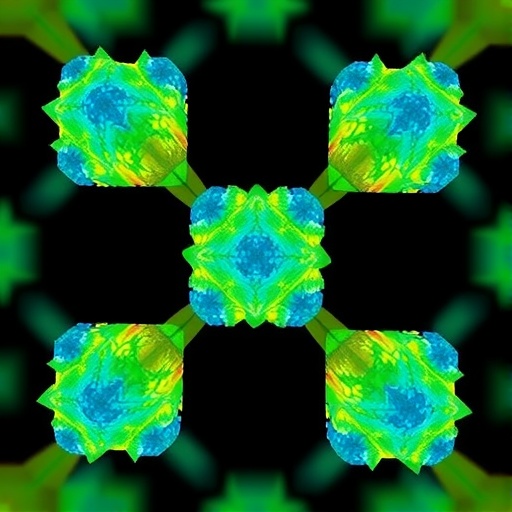Sodium-ion batteries (SIBs) are rapidly emerging as a promising alternative to lithium-ion batteries (LIBs), addressing critical limitations in resource availability, cost, and sustainability. A recent breakthrough by researchers from the University of Jaffna and Imperial College London offers an in-depth computational analysis of Na₂FeSiO₄, a sodium-based cathode material that combines earth abundance with remarkable electrochemical promise. Their findings, published in Frontiers in Energy, dissect the atomic-scale mechanisms underlying ion transport and material stability, highlighting pathways to optimize this material for next-generation energy storage applications.
The urgency to find viable substitutes for lithium-ion battery technology stems from global lithium shortages and geopolitical imbalances in lithium supply chains. Sodium, in contrast, ranks as the sixth most abundant element on Earth and is ubiquitously accessible. This reality positions sodium-ion batteries as a transformative technology for grid-scale storage, electric vehicles, and renewable energy integration, potentially democratizing energy access worldwide. However, the success hinges on discovering cathode materials that sustain high capacity, structural integrity, and efficient ion mobility.
Na₂FeSiO₄ has emerged as a material of interest due to its outstanding theoretical capacity of 276 mAh/g and robust thermal stability, withstanding temperatures up to 1000°C without degradation. Notably, its framework experiences minimal volume variation during charge and discharge, a crucial factor for enhancing battery lifespan and safety. Yet, despite these advantages, the material’s ionic conductivity and electrochemical kinetics require substantial improvement to reach practical deployment levels.
Leveraging advanced atomistic simulations paired with density functional theory (DFT), the research team embarked on a comprehensive exploration of Na₂FeSiO₄’s crystal lattice, intrinsic defect landscape, sodium-ion migration pathways, and the influence of dopants at the atomic scale. Their computational approach elucidated the mechanisms powering Na-ion diffusion and identified dopants that could tailor the material’s physical and electronic properties for optimized performance.
Central to the battery’s function is the migration of sodium ions through the crystal structure. The researchers uncovered that sodium ion transport in Na₂FeSiO₄ predominantly occurs via a vacancy-mediated mechanism, with activation energies calculated at an impressively low range of 0.38 to 0.41 eV. This barrier is significantly lower than in structurally similar silicate cathodes, such as Na₂MnSiO₄ (0.81 eV) and the lithium-containing Li₂Na₂FeSiO₄ (0.83 eV), indicating more facile ion kinetics that could translate to superior charging rates and power output in batteries.
Further scrutiny of intrinsic defects revealed the sodium Frenkel pair—comprising a sodium vacancy and a sodium interstitial—as the most energetically favorable defect with a formation energy of 1.71 eV. This finding suggests that the presence of such defects can naturally enhance ionic conductivity by providing dynamic pathways for ion hopping, essential for sustaining efficient charge-discharge cycling.
To augment these native properties, the team examined a suite of dopants with varying valence states to strategically modify the material’s behavior. Isovalent dopants like potassium (K) at sodium sites, zinc (Zn) at iron sites, and germanium (Ge) replacing silicon emerged as optimal candidates. Their isoelectronic nature preserves charge neutrality, ensuring the lattice structure remains intact while subtly tuning the local electronic environment and ionic pathways.
Conversely, aliovalent dopants introduced controlled charge imbalances that can manipulate defect concentrations and sodium content. Gallium (Ga) substituting iron facilitates the formation of sodium vacancies, effectively increasing ionic conductivity by creating more vacancies that serve as ion diffusion channels. Aluminum (Al) incorporated at silicon sites notably increases sodium content within the structure, a modification that could realistically enhance the battery’s overall capacity by providing more mobile charge carriers.
Through these computational insights, the study outlines a balanced doping strategy that enhances Na₂FeSiO₄’s structural stability and electrochemical properties while avoiding detrimental electronic defect states, which commonly plague polyanionic cathode materials.
Beyond its electrochemical potential, Na₂FeSiO₄ presents environmental benefits that distinguish it from many battery materials. Constructed from nontoxic, plentiful elements such as iron, silicon, and sodium, it offers a sustainable solution aligned with circular economy principles. The monoclinic polymorph investigated features a three-dimensional interconnected tetrahedral framework, providing a stable and rigid scaffold that maintains structural coherence during repeated sodium-ion intercalation and deintercalation cycles, even at elevated temperatures.
The research articulates the delicate balance required to transform a promising compound into a commercially viable battery cathode. It connects fundamental atomic phenomena with macroscopic performance parameters, bridging a critical knowledge gap. Poobalasuntharam Iyngaran, the corresponding author, emphasizes the significance of this linkage, noting that the work serves as a vital roadmap for advancing sodium-ion batteries to compete with and complement existing lithium-ion technologies, especially in applications demanding large-scale, low-cost energy storage.
Looking ahead, the path laid out by this study encourages experimentalists to validate the computational predictions and explore synergistic co-doping strategies that could further enhance material performance. Investigating temperature effects on defect dynamics and long-term electrochemical cycling will be pivotal to ascertain Na₂FeSiO₄’s durability under real-world operational stresses. As renewable energy production accelerates worldwide, the ability to reliably store vast amounts of intermittent solar and wind power using optimized sodium-ion batteries could substantially reduce reliance on fossil fuels and catalyze the global energy transition.
This research underscores the pivotal role of computational materials science in the energy landscape, providing critical atomic-level insights that drive material innovation without costly trial-and-error in the laboratory. With continued interdisciplinary collaboration, Na₂FeSiO₄ and similar materials could soon underpin a new generation of sustainable, affordable, and high-performance battery technologies.
In sum, the Na₂FeSiO₄ system represents not just a cathode material, but a beacon for the future of energy storage—offering a platform where earth-abundance, safety, and high electrochemical performance converge. As we confront escalating global energy demands and environmental challenges, advancements like these point the way toward batteries that empower a greener, more equitable world.
Subject of Research: Not applicable
Article Title: Na₂FeSiO₄ as a sodium-ion battery material: A computational perspective
News Publication Date: 14-Oct-2025
Web References:
https://doi.org/10.1007/s11708-025-1040-2
Image Credits: HIGHER EDUCATION PRESS
Keywords
Energy, Sodium-ion batteries, Cathode materials, Na₂FeSiO₄, Density functional theory, Ion transport, Dopants, Sustainable energy storage




